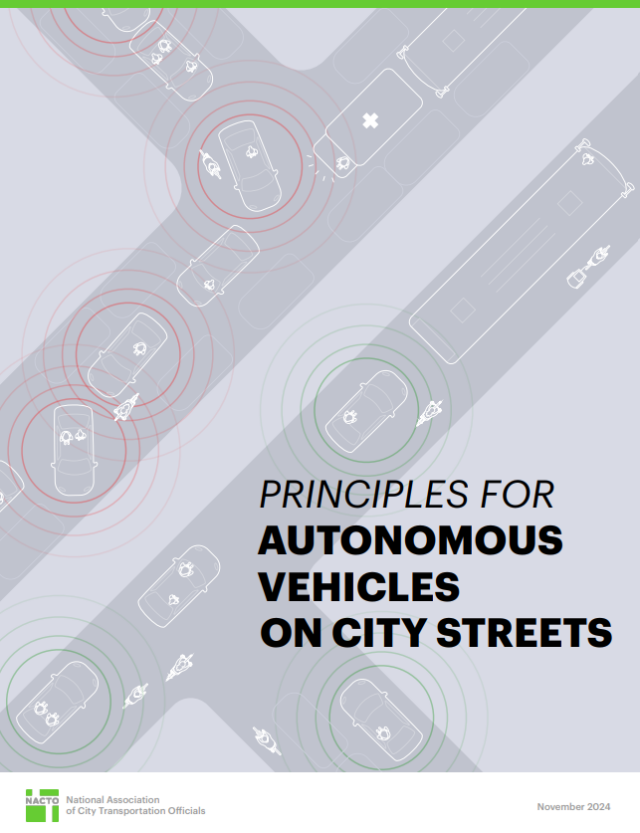When done right, autonomous vehicles offer an opportunity to make streets safer, increase access to transportation for underserved communities, and increase American industry competitiveness in the international market. When done haphazardly, incorporating AVs and AV testing into our streets will make our cities less safe, less equal, and more congested.
NACTO’s new Principles for Autonomous Vehicles on City Streets help all actors–cities, states, federal regulators, and AV companies–successfully integrate AVs into existing, complex city streets and transportation systems.
→ Principle 1: Expect safety excellence from AV operators
→ Principle 2: Empower cities as stewards of AVs in urban areas
→ Principle 3: Ensure affordability and accessibility
 NACTO and our member agencies—100 cities and transit agencies across the U.S. and Canada—believe that an autonomous future is centered on people and restoring life to our streets.
NACTO and our member agencies—100 cities and transit agencies across the U.S. and Canada—believe that an autonomous future is centered on people and restoring life to our streets.
NACTO’s previous work expressed optimism for this technology, balanced with the urgency for clear, forward-thinking federal, state, and local policies necessary for an autonomous future to center humans in our cities.
Since then, the landscape of automated vehicle policy and technology has continued to evolve. Multiple companies are currently conducting large-scale testing and deployment of AV fleets in cities across the country. These AV fleets arrived with much fanfare and expansive corporate promises: a once-in-a-generation opportunity to solve the traffic safety crisis on U.S. streets that will also expand mobility options, including for people with disabilities, and deliver goods more efficiently and sustainably.
Yet these benefits are difficult to imagine based on cities’ experiences today. NACTO member city staff have documented instances of AVs being unresponsive to clear signs of emergency operations, such as fire trucks stopped with their lights on and public safety personnel directing traffic.
Residents experiencing these direct negative impacts turn to their city leaders, but cities lack the legal authority to respond. Despite the clear need for a role in overseeing AV operations in their local neighborhoods, cities are too often excluded from regulatory efforts at the state and federal levels.
Cities must be able to make decisions for their transportation system. Our principles call for specific changes that will allow cities to inform and shepherd the deployment of AVs. These recommendations include:
- U.S. DOT must organize a new stakeholder group to bring together cities, states, the federal government, and private industry. Cities need a centralized way to engage with private industry AV operators and their governmental counterparts at the state and federal levels. Both the positive and negative impacts of AVs are experienced at the local level, but the city staff who represent local needs and interests are often left out of conversations among stakeholders, including other government agencies. The most effective regulation will come from the input of cities that regularly experience operational and implementation impacts, since vehicles operating on city streets raise unique local concerns.
- Cities must not be restricted in their ability to enforce local traffic laws and develop regulations for AV fleets operating on local streets. Three major U.S. cities–Las Vegas, Phoenix, and San Francisco–have reported being unable to write moving violation tickets if there’s no driver, raising questions about civil liability. In Arizona, for example, the city instead is directed to give tickets to the company that owns the vehicle–a challenging and often infeasible task. However, AVs are not operationally the same as traditional vehicles, given the absence of a human driver.
- Cities must have the authority to enact equity-focused requirements for commercial AV services and should not be preempted from doing so through local and state licensing for operations. If unregulated, commercial AV fleets will not prioritize equitable access for low-income people nor people with disabilities. Without intervention, AV fleets could exacerbate transportation inequities, increase single-occupancy vehicle travel, and undermine public transit. Cities also need the power to best direct the benefits of these new technologies to the people who need them most.
We must ensure that the best and safest technologies are on the market and available to everyone, especially those who need them most. At NACTO, we’ve worked alongside our member cities to build the future we want to see, laying the groundwork for a more sustainable and equitable future even as change is happening around us.
As we look ahead, cities must play a critical role in shaping how autonomous vehicles and technology more broadly contribute to the safety, sustainability, equity, and vibrancy of our communities.
Read the full policy statement (pdf) >